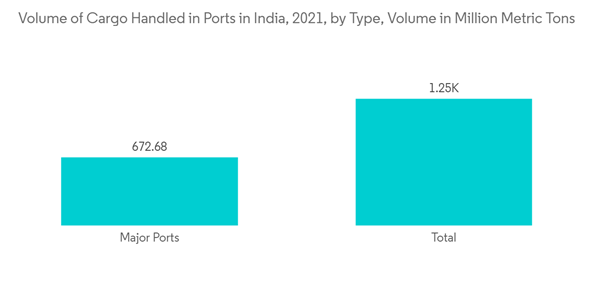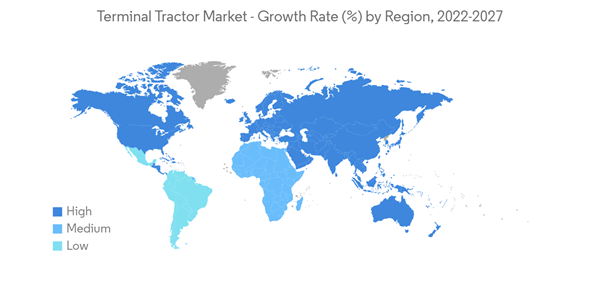The Terminal Tractor Market is valued at USD 662 million currently, and it is expected to reach USD 861 million, registering a CAGR of above 4.32% during the forecast period.
The COVID-19 pandemic has affected almost every other industry in the market, and the impact on the terminal tractor market has been inevitable as supply chain disruptions and the shutdown of manufacturing units delayed the production of necessary critical components.
Although, 2021 has remarked itself as a period of transition where the complete terminal tractor production unit recovered and regained its growth phase by revamping production capacities across the globe.
This market growth can be attributed to port terminal automation and the rising demand for electric and hybrid equipment for lower emissions and fuel consumption. Other positive factors responsible for the adoption of terminal tractors are increasing trade activities in Asian and Middle Eastern countries. In addition, the increasing demand for container handling is also largely influencing the growth of the terminal tractor market.
Asia-Pacific holds the largest market share as the region consists of a large number of container ports where the demand for terminal tractors is high. Europe is anticipated to witness the fastest growth during the forecast period due to increased maritime activities and the adoption of automated terminal tractors.
Electric terminal tractor apart from providing the required clout and control also keeps up a variety of eco-friendly upgrades that can help diminish the adverse impact a business has on the environment. With rising concerns for ecofriendly and sustainable transport across the globe, demand for electric terminal tractors at various transportation locations is anticipated to hold high growth potential.
Several industries including port and transportation, supermarket are actively deploying electric terminal tractors to fuel their respective use cases and reduce carbon emissions. For instance:
Thus, considering these aforementioned deliveries, market is anticpated togain traction from rising sales of electric terminal tractors during the forecast period.
Also, this region has a high adoption rate of automation technologies. Equipment with high automation levels increase productivity. This region is home to automated terminals such as the ECT Delta Port terminal (Netherlands) and the HHLA CTA terminal (Germany). The number of automated terminals is expected to increase in this region, further driving the growth of terminal tractors.
In Europe, marine and trade activities have long been drivers of economic growth, providing natural resources and access to trade and transport and opportunities for recreation. In addition, the consumer shift toward e-commerce platforms is offering a significant opportunity to terminal tractor manufacturers for their applicability in logistics and distribution handling. For instance,In May 2022, Hyster announced the non-biding MoU in order to provide Hamburg Hafen and LogistiK AG two electric terminal tractor powered by fuel cells. The delivery came under the initiative of the clean port and logistic program managed by Hyster.
At the same time, manufacturers are optimistic that the resumption of production plants across several countries will enable them to move toward a recovery phase, which is foreseen to stabilize the progress of the terminal tractor market in Europe.
These players are investing heavily in the R&D of terminal tractors to provide green and clean fuel-driven tractors to protect the environment and generate high power. For instance, In August 2022, Terberg Tractors Malaysia developed an autonomous terminal tractor in partnership with Aidrivers. The partnership came in 2019 which consistently aimed to produce an autonomous ecosystem inside the terminal tractor.
This product will be delivered within 2 business days.
The COVID-19 pandemic has affected almost every other industry in the market, and the impact on the terminal tractor market has been inevitable as supply chain disruptions and the shutdown of manufacturing units delayed the production of necessary critical components.
Although, 2021 has remarked itself as a period of transition where the complete terminal tractor production unit recovered and regained its growth phase by revamping production capacities across the globe.
This market growth can be attributed to port terminal automation and the rising demand for electric and hybrid equipment for lower emissions and fuel consumption. Other positive factors responsible for the adoption of terminal tractors are increasing trade activities in Asian and Middle Eastern countries. In addition, the increasing demand for container handling is also largely influencing the growth of the terminal tractor market.
Asia-Pacific holds the largest market share as the region consists of a large number of container ports where the demand for terminal tractors is high. Europe is anticipated to witness the fastest growth during the forecast period due to increased maritime activities and the adoption of automated terminal tractors.
Terminal Tractor Market Trends
Growing Demand for Electric Terminal Tractors
The rise in fuel prices contributes to the demand for electric terminal tractors. Traits like zero emissions and relatively less energy consumption have made them a viable choice among various end users. Also, electric terminal tractors are far smoother, flatter, and slicker than traditional diesel-operated terminal tractors.Electric terminal tractor apart from providing the required clout and control also keeps up a variety of eco-friendly upgrades that can help diminish the adverse impact a business has on the environment. With rising concerns for ecofriendly and sustainable transport across the globe, demand for electric terminal tractors at various transportation locations is anticipated to hold high growth potential.
Several industries including port and transportation, supermarket are actively deploying electric terminal tractors to fuel their respective use cases and reduce carbon emissions. For instance:
- November 2022, Autocar LLC which is the manufacturer of severe duty vocational trucks announced the delivery of its all electric battery terminal tractor at the Stater Bros. Supermarket.
- In June 2022, DP world announced the delivery of 11 all electric terminal tractor Terberg YT203-EV at the London Gateway which will be utilized primarily in the transporting goods to the nearby logistic facility.
Thus, considering these aforementioned deliveries, market is anticpated togain traction from rising sales of electric terminal tractors during the forecast period.
Europe is Expected to Witness Significant Growth
Europe is expected to be the largest market during the forecast period due to the presence of robust economies of European countries such as Germany, the United Kingdom, and Spain, along with the presence of leading manufacturers of terminal tractors. Konecranes, Kalmar, MAFI, CVS Ferrari, and MOL CY are key manufacturers catering to the global market through dealer and distribution networks.Also, this region has a high adoption rate of automation technologies. Equipment with high automation levels increase productivity. This region is home to automated terminals such as the ECT Delta Port terminal (Netherlands) and the HHLA CTA terminal (Germany). The number of automated terminals is expected to increase in this region, further driving the growth of terminal tractors.
In Europe, marine and trade activities have long been drivers of economic growth, providing natural resources and access to trade and transport and opportunities for recreation. In addition, the consumer shift toward e-commerce platforms is offering a significant opportunity to terminal tractor manufacturers for their applicability in logistics and distribution handling. For instance,In May 2022, Hyster announced the non-biding MoU in order to provide Hamburg Hafen and LogistiK AG two electric terminal tractor powered by fuel cells. The delivery came under the initiative of the clean port and logistic program managed by Hyster.
At the same time, manufacturers are optimistic that the resumption of production plants across several countries will enable them to move toward a recovery phase, which is foreseen to stabilize the progress of the terminal tractor market in Europe.
Terminal Tractor Market Competitor Analysis
The terminal tractor market is moderately consolidated, with several players accounting for a smaller portion of the market share. Some of the prominent companies in the market are Kalmar, Konecranes, Sany, Hyster, and others. Players are also offering autonomous terminal tractors under the pool in order to witness prominence.These players are investing heavily in the R&D of terminal tractors to provide green and clean fuel-driven tractors to protect the environment and generate high power. For instance, In August 2022, Terberg Tractors Malaysia developed an autonomous terminal tractor in partnership with Aidrivers. The partnership came in 2019 which consistently aimed to produce an autonomous ecosystem inside the terminal tractor.
Additional benefits of purchasing the report:
- The market estimate (ME) sheet in Excel format
- 3 months of analyst support
This product will be delivered within 2 business days.
Table of Contents
1 INTRODUCTION
4 MARKET DYNAMICS
5 MARKET SEGMENTATION (Market Size in Value USD Million)
6 COMPETITIVE LANDSCAPE
Companies Mentioned (Partial List)
A selection of companies mentioned in this report includes, but is not limited to:
- Konecranes Oyj
- Kalmar Global
- CVS Ferrari SPA
- Sany Heavy Industry Co. Ltd
- Hyster-Yale Materials Handling, Inc.
- Linde PLC
- Volvo AB
- Mol CY
- Liebherr Group
- Terberg Group BV
Methodology

LOADING...










